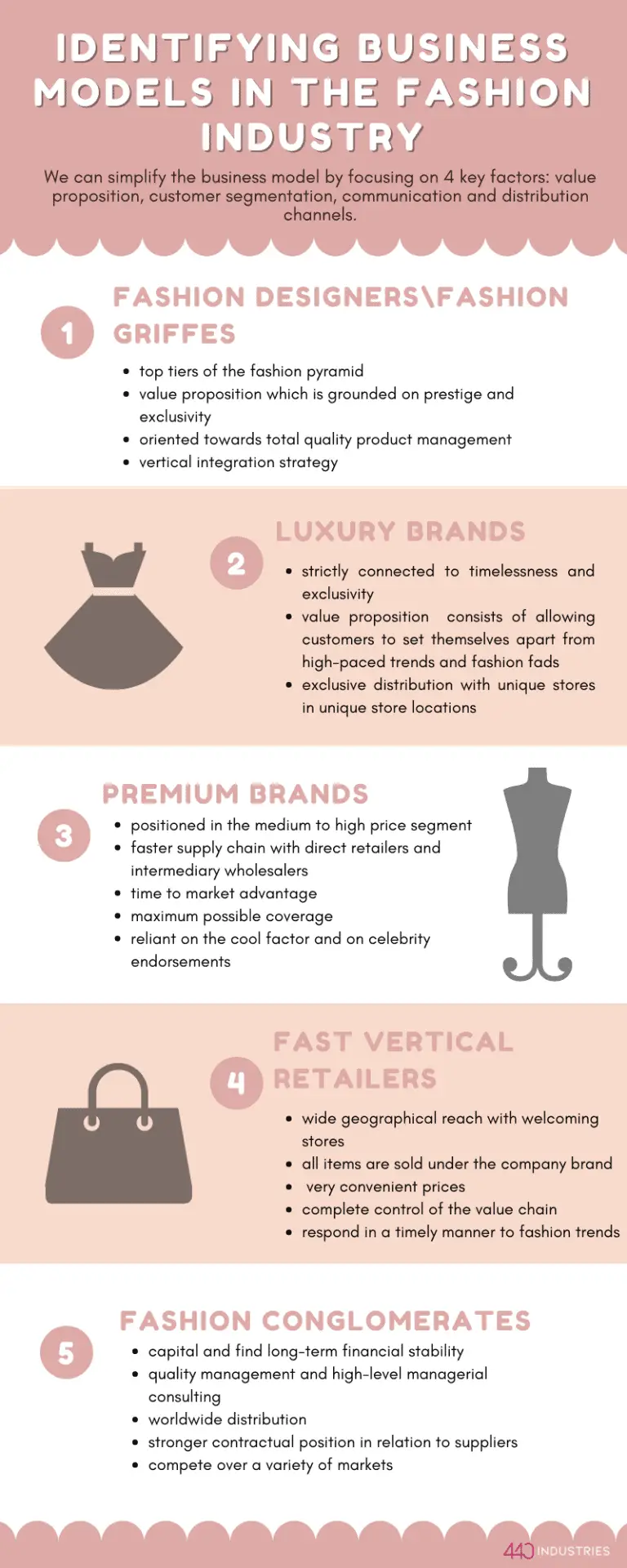Introduction
A business model represents the internal logic of a firm. As managing a business entails for a high degree of complexity, a business model allows managers to visually simplify the inner workflow of the firm and identify the 9 essential building blocks that bring value to the market.
In the fashion industry, we can additionally simplify this model by a focus on the 4 key factors that set firms apart: its value proposition, customer segmentation, communication and distribution channels and the degree of complexity of the firm’s value chain. The core element of a business model is found in the connection created by the company’s value proposition – or the solution – and the target market – or the customers the company wishes to help.
The business model canvas is a very popular and useful tool to define the value proposition of a company and is discussed in greater detail in this post.
In this article we are going to discuss instead the most important fashion business models, identifying the unique aspects of each model:
- Fashion designersfashion Griffes
- Luxury brands
- Premium brands
- Fast vertical retailers
- Fashion Conglomerates
- Conclusion
1. Fashion designersfashion griffes
This business model is the one adopted by firms wishing to compete on the top tiers of the fashion pyramid. The business model of these typologies of companies revolves around a value proposition which is grounded on prestige and exclusivity. Let’s see a selection of the distinctive elements that set this business model apart:
- Dream factor and the role of the designer. In order to deliver the dream factor effect capable of associating aspirational values to a firm’s products, companies use fashion media to deliver a narrative capable of conveying intangible brand values. This is effectively done by creating an appeal through the fashion media industry and the press. The figure of the designer in this context is extremely important as the designer delivers the most persuasive elements of the brand, and becomes the scale of a firm’s success or failure. A famous example is provided by Tom Ford, who assisted Gucci in becoming a credible global brand.
- From contract manufacturing to forwarding integration. Another distinctive feature of this business model relates to the vertical integration strategy pursued by fashion firms in this segment. Designers will start controlling more in-depth the production pipeline by selecting licensees, or contract manufacturers which will create products using the licensor’s brand name. In a later stage, by pursuing a forward integration strategy, many fashion designers try to completely manage the manufacturing stage of the pipeline by acquiring shares in partner companies. This step, oriented towards total quality product management will allow firms, to compete with neighbouring fashion market segments, either by exploiting industrial efficiencies in the bridge sector or by creating high-quality goods for the luxury market.
2. Luxury brands
Even if the concepts of fashion and luxury are sometimes used as synonyms, these two concepts stand for completely different sets of value associations.
Luxury is strictly connected to timelessness and exclusivity. In luxury, the timeless and heritage-sensitive values of a brand can be ‘stretched’ to cover a wide range of product categories, including watches, cosmetics and leather products. In this case, we can look more in-depth into the 4 elements of the business model of luxury.
- Value proposition. The value proposition of luxury brands consists of allowing customers to set themselves apart from high-paced trends and fashion fads, by owning iconic pieces of style which will never become old or outdated. Luxury brands represent an attestation of social status, or better yet, they can be considered a social currency.
- Customer segmentation. Luxury brands ideally focus primarily on customers who are sometimes described with the acronym HNWI (High Net Worth Individuals). For this type of customers, the price point is uninfluential in the purchase decision, as they tend to value much more the experiential component of shopping, more than they value money. This does not mean however those luxury companies are not interested in more ‘average consumers’. As discussed in the post: Market Segmentation in the Fashion Industry, luxury brands can ‘commoditise’ luxury by stretching their brand equity and applying their brand to other product categories, to leverage the dream factor effect on a much wider audience. This is what is usually intended with the term ‘masstige’ or mass-prestige, indicating the ‘democratisation’ of luxury goods.
- Communication. Luxury companies revolve around a sense of heritage and tradition which in many cases if more than a century old. This allows them to promote their products with discretion, by avoiding the ‘buzz’ factor that many other fashion firms need to ignite desire into their customers. True luxury firms do not even advertise their products, as much as ‘unveil’ them to a selection of exclusive clients.
Luxury companies moreover, when engaged in communication campaigns stay away from promoting a particular product, as what they focus on is the narrative and heritage of the brand. In the words of Simon Sinek, they focus on the Why rather than the What or How. This approach allows them to further distance their brands from the tumultuous competition of premium brands, in order to deliver a message connected to passion and purpose.
- Distribution. In marketing terms, the distribution strategy pursued by luxury firms is exclusive distribution. In the luxury segment, companies need to deliver a shopping experience capable of conveying the full potential of their brand narrative. Directly owned retail is a mandatory requirement for luxury companies who need to create an environment capable of educating, informing, entertaining their customers. This is why in luxury, companies develop their market by creating ‘flagship stores‘, unique stores, in unique store locations that allow firms to fully deploy the theatrical and educational elements of the brand. These stores do not focus on sales, as much as in creating a stage, to foster the interaction between a variety of brand stakeholders.
Even if the concepts of fashion and luxury are sometimes used as synonyms, these two concepts stand for completely different sets of value associations.
Luxury is strictly connected to timelessness and exclusivity. In luxury, the timeless and heritage-sensitive values of a brand can be ‘stretched’ to cover a wide range of product categories, including watches, cosmetics and leather products. In this case, we can look more in-depth into the four elements of the business model of luxury.
- Value proposition. The value proposition of luxury brands consists of allowing customers to set themselves apart from high-paced trends and fashion fads, by owning iconic pieces of style which will never become old or outdated. Luxury brands represent an attestation of social status, or better yet, they can be considered a social currency.
- Customer segmentation. Luxury brands ideally focus primarily on customers who are sometimes described with the acronym HNWI (High Net Worth Individuals). For this type of customers, the price point is uninfluential in the purchase decision, as they tend to value much more the experiential component of shopping, more than they value money. This does not mean however those luxury companies are not interested in more ‘average consumers’. As discussed in the post: Market Segmentation in the Fashion Industry, luxury brands can ‘commoditise’ luxury by stretching their brand equity and applying their brand to other product categories, to leverage the dream factor effect on a much wider audience. This is what is usually intended with the term ‘masstige’ or mass-prestige, indicating the ‘democratisation’ of luxury goods.
- Communication. Luxury companies revolve around a sense of heritage and tradition which in many cases if more than a century old. This allows them to promote their products with discretion, by avoiding the ‘buzz’ factor that many other fashion firms need to ignite desire into their customers. True luxury firms do not even advertise their products, as much as ‘unveil’ them to a selection of exclusive clients. Luxury companies moreover, when engaged in communication campaigns stay away from promoting a particular product, as what they focus on is the narrative and heritage of the brand. In the words of Simon Sinek, they focus on the Why rather than the What or How. This approach allows them to further distance their brands from the tumultuous competition of premium brands, in order to deliver a message connected to passion and purpose.
- Distribution. In marketing terms, the distribution strategy pursued by luxury firms is exclusive distribution. In luxury, companies need to deliver a shopping experience capable of delivering the full potential of their brand narrative. Directly owned retail is not an option luxury companies who need to create an environment capable of educating, informing, entertaining their customers. This is why in luxury, companies develop their market by creating ‘flagship stores‘, unique stores, in unique store locations that allow firms to fully deploy the theatrical and educational elements of the brand. These stores do not focus on sales, as much as in creating a stage, to foster the interaction between a variety of brand stakeholders.
3. Premium Brands
This category of products is more heterogeneous, as it relates to brands which are positioned in the medium to high price segment. The value of these brands is delivered through a clear brand vision, capable of connecting the value of the brand to volumes and scales delivered by the manufacturing industry, and a large network of suppliers.
This business model is more associated with a good pricequality ratio which is obtained through product specialisation and production optimisation. Companies in this prices segment need to be aware of their TTM (time to market) in order to strike a balance between a higher quality apparel production and a faster fashion seasonality. A faster supply chain is also achieved by leveraging on two types of distributors: direct retailers and intermediary wholesalers.
The competition in this segment will, therefore, operate on a variety of levels:
- Time to market advantage. Premium brands are required to be responsive to faster fashion trends and will need to be able to manage their global value chain in order to maintain profitability and a fast time to market. This can be done also by creating more standardisedglobalised products which are able to fit with little to no adaptation to a wide variety of international markets.
- Extensive distribution. Premium brands pursue industrial efficiencies such as economies of scale and economies of scope. As a result, their distribution strategies are oriented towards obtaining the maximum possible coverage. This can be done with owned self-standing stores, but it’s also achieved by creating an extensive wholesale distribution through partnerships with trade customers and intermediaries.
- Communication and advertising. In an inflated and saturated market like the one belonging to premium brands, companies need to develop effective marketing plans to acquire and maintain market share. In this context, where fewer quality or heritage values can be drawn, competition is much more reliant on the cool factor and on celebrity endorsements.

4. Fast vertical retailers
This business model is connected to companies which pursue the development of speciality chains with a wide geographical reach. Examples of companies pursuing this business model are Terranova, Zara, H&M and Top Shop.
Their value innovation can be found in the creation of a flow of fashionable merchandise channelled through an extensive distribution network comprised of stores located in prime locations. Fast retailers create welcoming stores, with very convenient prices, where their vertically integrated organisational structure allows them to effectively manage their value chain and deliver value while achieving a high level of profitability. This typology of a company is, in fact, capable of collecting margins which would normally pertain to both the fashion producer and fashion retailer.
Other relevant characteristics of vertical retailers include:
- The complete control of the value chain
- The creation of a standardised store concept, where all items are sold under the company brand
- The ability to respond in a timely manner to fashion trends
- The minimisation of sales risks due to efficient value chain management
By analysing fast fashion retailers we can see how this business model is very close to the one pursued by digital businesses distributing their products through e-commerce stores. Fast fashion companies are designed to manage their pipeline on the grounds of intensive data-driven analysis capable of maximising the production of those items which are most likely to sell. Moreover, the high speed of operations allows for a fast turnover of merchandise. Fast fashion retailers are capable of restocking inventory every 6 weeks.
5. Fashion Conglomerates
Since the 90s it has become common practice to grow fashion companies by acquiring promising brands and designer ateliers. This growth strategy has allowed larger fashion companies to become fashion conglomerates, managing a wide portfolio of business models and brands.
When two companies enter a buyer-seller relationship both the “acquirer” and the “acquired” gain benefits making the conglomerate model of growth a viable business strategy in the fashion industry.
The benefits of this model for an acquired brand entails the opportunity to access:
- Capital and find long-term financial stability
- Quality management and high-level managerial consulting
- Worldwide distribution
- A stronger contractual position in relation to suppliers
The benefit for the conglomerate ultimately relates to managing a sufficiently diversified brand portfolio allowing it to compete over a variety of markets.
Fashion conglomerates like LVMH, are able to follow this model and identify new designers, brands and organisations which, through funding and expert managerial guidance can achieve market success.
6. Conclusions
As we have discussed fashion firms have a wide variety of business models to choose from as they develop their brands. Moreover, as we have seen in the case of masstige, firms may be able to cut and paste different business model blocks to create a unique value proposition.
Recently, academic and business literature has noted how companies are now understanding the benefits of moulding an organisation’s internal processes to reach the final customer. As a result firms have devised strategies oriented towards the creation of an innovative concept: the business model portfolio. This allows to create maximum differentiation across the firm’s activities and provide firms with the strategic tool to engage with their end customer.
Customers are in fact at the heart of any brand management strategy. We’re going to discuss this topic in more detail in the next instalment, entitled: Consumer Segmentation in the Fashion Industry.
If you’re interested in learning more about the Fashion Industry, don’t hesitate to take a look at our course “The Fashion Industry: Explained”. Our in-depth class covers a wide range of topics spanning from understanding fashion customers and markets to developing immersive retail experiences for your customers. Here’s a link to the course, if you use the discount code BLOG20 you can access a 20% discount. Enjoy!







